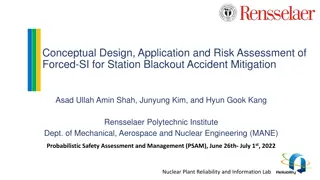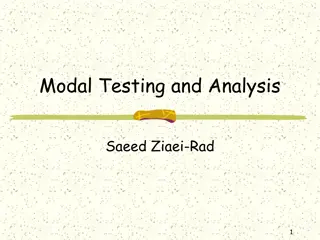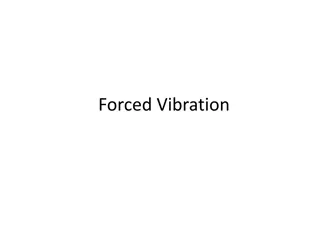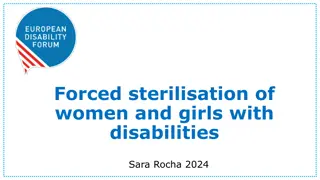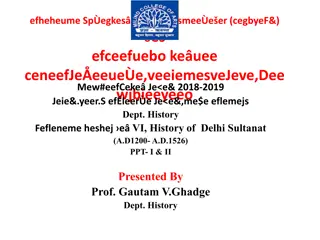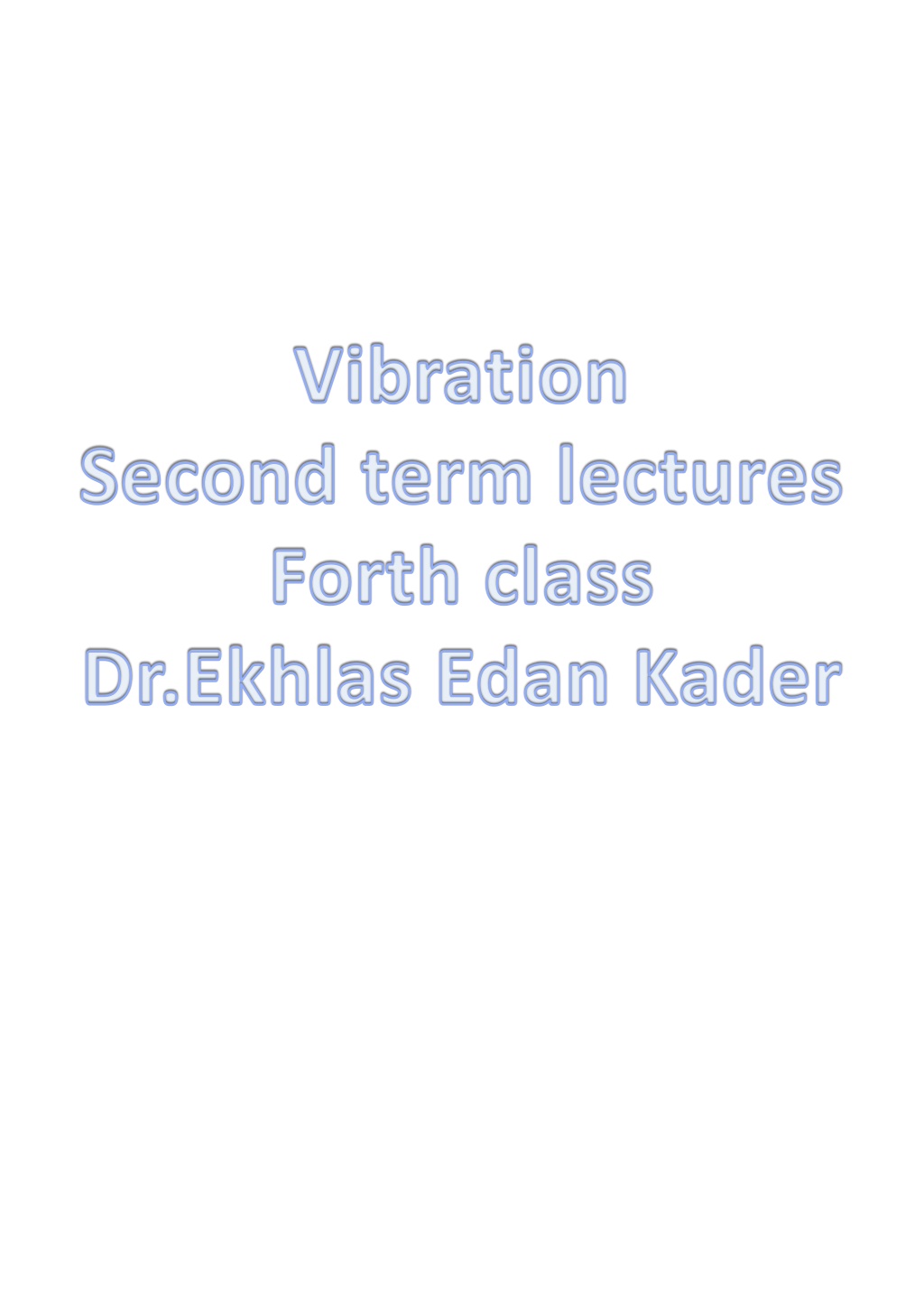
Vibrations in Mechanical Systems: Analysis and Solutions
Explore the lecture material on vibrations in mechanical systems, focusing on concepts like frequency ratio, damping ratio, and steady-state response. Understand the calculations and solutions related to harmonic excitation and forced vibration under base motion.
Download Presentation

Please find below an Image/Link to download the presentation.
The content on the website is provided AS IS for your information and personal use only. It may not be sold, licensed, or shared on other websites without obtaining consent from the author. If you encounter any issues during the download, it is possible that the publisher has removed the file from their server.
You are allowed to download the files provided on this website for personal or commercial use, subject to the condition that they are used lawfully. All files are the property of their respective owners.
The content on the website is provided AS IS for your information and personal use only. It may not be sold, licensed, or shared on other websites without obtaining consent from the author.
E N D
Presentation Transcript
Vibration Second term lectures Forth class Dr.Ekhlas Edan Kader
The frequency ratio r is givenby ? = ?= 20 = 1.428 14 ?? The steady-state amplitude is related to the magnification factorby ??2? 1 ? = ?0 1 ?2 2 + (2??)2 20 1420.002 20 1 = 2 1 1.4282 2 + 2? 1.428 1 0.392 = 1.0799 +8.1567?2 Or From which =0.8157 Example 4.8 A 25kg mass is mounted on an isolator pad whose stiffness is 5x105 N/m. when the system is subjected to a harmonic excitation of magnitude 300N and frequency 100 rad/sec. the phase difference between the excitation and the steady-state response is 25 deg. Determine : (a) (b) The damping ratio of the isolator pad and The isolator pad's maximum deflection due to this excitation . Solution: The natural frequency of the system is (a)
=?=?????= ???. ? ???/??? ? ? ?? ? ??? ? The frequency ratio is = ? = = ?.??? ???.??? ?? The phase angle is given by = ??? ???? ? ?? From which ? = ? ??= ??? ?? =? (?.???)? ?(?.???) ? = ?.??? ????? (b) The amplitude is related to the magnification ???? ? ?= ?? ? ?? ?+(???)? From which the amplitude is obtainedas ?? ? = ????? ?? ?+ ???? ??? = ? ?? ???. ????? ?. ???? ?+ ? ?. ???? ?. ??? =0.0002719 or 0.2719mm RESPONSE OF DAMPED SYSTEM UNDERBASE EXCITATION In many mechanical systems such as vehicles mounted on a moving support or base, the forced vibration of the system is due to moving support or base. The motion of the support or base causes the force to be transmitted to the mounting equipment.
Figure 4.9(a) shows a damped single-degree-of-freedom mass- spring system with a moving support or base. Fig. 4.9 The support motion y is assumed to be harmonic and the displacement of the mass is measured from its equilibrium position Letting ? = ?? ????? and applying Newton's second law the free-body diagram of the mass as shown in fig 4.9 (b) andassuming x>ys the equation of motion of the mass is ? = -k(x-y) ( - ) ---------(56) m + c + kx =ky +c By using y=Yo ????? Eq.above becomes:- ? + ? + ?? = ??? ????? + ????cos ??--------(57) The right-hand side of Eq. (4.57) can be written as ???????? + ????cos ?? = ???2 + (??)2 sin (??+ ?)--(58) Where the phase angle ?is given by : ?= tan 1??= tan 1(2??)------(59)? Substitution Eq. (4.58) in to Eq.(4.57) gives or ?? + ?? + ?? = ???2 + ??2 sin ?? + ? ?? + ?? + ?? = ??? 1 + 2??2 sin ?? + ?----(60) Or This Eq. is in a similar form to Eq. (4.34) therefore the steady state solution xpis
???2 + ??2 ?? ? = ??? ?? + ? ? ?? ?+ ???? Where the phase angle is given by = tan 1(2?? 1 ?2) Equation (4.61) can be written in compact form as: ??? = ?0 ??sin(?? + ?) Where ??is the magnificationfactor 1 + (2??)2 (1 ?2 )2 +(2??)2 ?? = The force carried by the support can be obtained using the free body diagram shown in fig. 4.9(b), as ?1 = ? ? ? + ? ? ? Which is equal to -m? . The acceleration ?is obtained by differentiating Eq. (4.63). the transmitted force is given by ?1 = ??????2 sin ?? + ? ? ? ? ? 2 ??? ?? + ? = ? ? ?2 ? = ??? ???2 ??? ?? + ? Where r = ?/??is the frequency ratio . using Eq.(4.61), the force transmited to the support can be written as ?21+(2??)2 (1 ?2)2+(2??)2 ??? ?? + ?1 = ????? ? The motion of the mass relative to the support denoted by z can be written as ? = ? ? And ?= ? ?
Equation (4.56)can be rewritten in terms of z as: ? ?+ ?= ?? ?? Which can be rewritten as ?+ ?? + ?? = ?? = ??0 ?2 sin?? The particular solution of this differential equation is : ?0 ?2 (1 ?2)2+(2??)2 ??0 ?2/? (1 ?2)2+(2??)2 sin(?? ) ? = sin ?? = Where the phase angle is defined by equation(4.62). Example 4.9 A 50 kg mass is attached to a base through a spring inparallel with a damper as shown in fig. 4.10 . The base undergoes a harmonic excitation of y(t)=0.20 sin 30t . The stiffness of the spring is 3*104 and the damping constant is 200Ns/m. Determine (a)the amplitude of the mass's absolute displacement relative to its base . C k m y(t)=0.20sin30t solution : the natural frequency of the system is
= ?=3104 =24.495???/??? ? ? 50 ? Frequency ratio 30 ? ? = = 1.2248 = 24.495 ?? Dampingratio 200 ? ? = = 0.0816 = 2(50)(24.495) 2??? a) The amplitude of the relative displacement is (0.20)(1.224)2 1 1.22482 2+ 2(0.0816)(1.2248)2 b) The amplitude of the absolute displacement is given by ??2 (1 ?2)2+(2??)2 = 0.5572 = 1+ 2(0.0816)(1.2248)2 1+(2??)2 (1 ?2)2+(2??)2 ? = ? (1 1.22482 )2+ 2 0.0816 (1.2248)2 = = 0.20 0.3444 Example 4.10 A racing car is modeled as a single-degree-of- freedom damped system vibration in the vertical direction . The elevation of the road assumed to vary sinusoidally . the distance from peak to trough is 0.2 m and the distance between the peaks is 70 m . the natural frequency of the system is 2 Hz and the damping ratio of the dampers is 0.15 Determine (a)the amplitude of vibration of the racing car at speed 120km/hr (b)the most unfavourable speed of the racing car if the speed of the racing car varies . Solution : Time taken by car to travel one cycle(70m)is ? =70 3600 120 1000= 2.1??? Excitation frequency ? = 2?= 2.992???/??? ? ? ??= 0.231 , ? = 0.15 Given ??= 2? 2 = 12.5664 ???/???, ? =
a) Amplitude of vibration of car is given by 1/2 1+(2??)2 ?= (1 ?2)2+(2??)2 ? 1/2 1+(2 0.15 0.2381) ? = 0.1 = 0.105977? (1 0.23182)2+(2 0.15 0.2381)2 b) The most unfavourable speed corresponds to the maximum value of X/Y in Eq.(E.1). For maximum of X/Y with respect to r . 1+4?2?2 ? = 0 1+?4 2?2+4?2?2 ?? 1+?4 2?2+4?2?2(8?2?) (1+4?2?2)(4?3 4?+8?2?)= 0 (1+?4 2?2+4?2?2)2 4? 2?2 ?4 + ?2 1 =0 ? = 0 ?? ?2 = 1 1+8?2 4?2 Feasible value of ?2 = 1+ 1+8(0.15)2 4(0.15)2 ? From which ,? = = 0.9791 ?? ? = 0.9791 12.5664 = 12.3035 ???/ sec =2? And ? Where ? = 70 3600 and ? = ????? ?? ??? ?? ??/?? ? 1000 Therefore unfavourable speed =12.3035 70 3.6= 493.4558??/?? 2? 4.4 ROTATING UNBALANCE Unbalance in many rotating mechanical system is a common source of vibration excitation which may often lead to unbalanced forces
.Unbalanced forces lead to excessive vibrations ultimately causing premature failure of system component such as bearings and couplings . figure 4.11 shows a damped , the single-degree-of- freedom machine which is supported elastically by a spring and a damper whose stiffness is k and damping coefficient is c . M Qm x c K The rotating component is mounted in bearings at O and rotates counterclockwise Fig. 4 . 1 1 R o t a t i n gu n b a l a n c e radians per second at an angular velocity of ? . The total mass of the system is ?and the system is assumed to vibrate only in the vertical direction .the mass distribution of the rotor is not uniform and therefore result in an equivalent eccentric mass ? located at a distance ? from the center of rotation . the component of the displacement of the eccentric mass ? in the vertical direction is givenby ??= ? + ? sin?? Where ? =the displacement of the machine in the vertical direction. ? =eccentricity (distance of mass ? from the center ofrotation) ?=angular velocity of the rotating component . ?=time The acceleration ??is obtained by differentiating Eq.(4.73)twice ??= ? ?2 ? sin ??
The total inertia forces of the machine can be writtenas ??????? ????? = ? ? ?+ ??? Where ?=the total mass of the machine including the eccentric mass ?. (? ?)=the mass of the machine which has acceleration ?. Referring to the free-body diagrams shown in Fig. 4.12 (a),(b)and (c) and applying Newton's second law of motion ,we have ? ? ?+ ??? = ?? ?? Using Eq.(4.47),Eq.(4.76)becomes ??+ ??+ ?? = ???2 sin?? Equation (4.77)is similar to Eq. (4.34) with ?0 = ???2 The natural frequency or the circular frequency of the systemis The steady state solution is givenby ?0 ??= 1 ?2+2??2sin(?? ?)
Where ? is the phase angle defined by Eq. (4.62) and constant ?0 in the case , is definedas f0 = me 2= k me 2 = m e r2 0x = 2M n M k ? where r is the frequency ratio ? = ?? ? And the damping ratio ? = ?? Substituting Eq. (4.81) into Eq. (4.80) yields Which can be written in a more compact form as ??? = ????sin(?? ?) ? In eq. (4.83) ,??is the magnification factor which is given by ? ?2 ?= 1 ?2+2??2 The steady state response ?(?) is given by Figure 4.13 shows the plot of the magnification factor ??versus the frequency ratio ? for different values of the damping factor ? . equation (4.86) shows that the steady vibration due to unbalance in rotating component is proportional to the amount of unbalance? and its distance ? from the center of the rotation and increases as the square of the speed of rotation . the maximum displacement of the system lags the maximum value of the forcing function by the phase angle ? .
Example 4.11 An electric generator weighing 981 N and operating at 600 rpm is mounted on four parallel springs of stiffness 5000 N/m . determine the maximum permissible unbalance in order to limit the steady- state deflection to 6mm peak-to-peak. Solution : ? = 2?(600) = 62.835 ???/??? 60 = 2000 = 14.142???/??? ??= ? ? 100
Where ?0= unbalanced mass ? = eccentricity ?0(62.835)2 20,000|4.44332 1| 3 x 10 3= Or ?0 ? = 0.2848 ??.? unbalance =?0 ?=(?0 ?)g =(0.2848)(9.81)=2.7939 Therefore Nm Example 4.12 The static deflection of an electric motor of mass 400kg supported by a system of four parallel springs and static-deflection is found to be 50 mm . if the electric motor has a rotating unbalance of 0.20 Kgm determine (a) the amplitude of vibration at 2000 rpm (b) the force transmitted to the ground . Solution: therefore ? = 78,480 ?/? RESPONSE OF VIBRATING SYSTEMS UNDER COULOMB AND HYSTERESIS DAMPING Coulomb damping As explained in the previous chapter , coulomb damping represents the damping that occurs due to dry friction between the surfaces sliding against one another .coulomb's law states that the frictional force is proportional to the
normal force developed between the mass and the surface . the constant or proportionality ? is known as the kinetic coefficient of friction . a single-degree-of-freedom subjected to a harmonic forcing condition and coulomb damping is shown in fig.4.19(a) . free body diagram of the mass ? is also shown in fig 4.19(b). An approximate analysis of the system is considered here . since with coulomb damping, the half-cycle of the motion curve are sinusoidal, it is assumed that if the coulomb friction is not large , the steady-state motion will be approximately harmonic of the same frequency as that of the forcing function. Let the motion be defined by theexpression ? = ????(?? ?) For viscously damped steady-state motion , assuming that an equevilant viscous damping constant can be introduced by considering the relationship between the energy absorption per cycle for the two cases. The energy dissipation per cycle for coulomb damping is given by, ??= 4?? Where ? is a constant force . Equating with the corresponding expression ? for the viscously damped system, we have ? = ?? ?????2 =4?? 4? ??? = ?? Now Eq. (4.108) can be substituted into the amplitude for the viscously damped system to get.
?0 ?0 ?0 ? = = = 1 ?2 2 +(4?/???)2 1 ?2 2+(??/?)2 1 ?2 2+(2??)2 Solving this for the amplitude ? gives ?21 ?2 2 + 4?=?2 0 ??? ?2 (4?/??)2 = ? 1 (4?/??0) 1 ?2 2 0 ? = 0 1 ?2 This expression for ? has a real value , provided that ? ? < 4?0 ?? 4? < ??0 For most practical applications, in Eq(4.110) is generally valid since ? is assumed to be small . if ? ??0, then the case4 represent a large friction force an exact analysis is recommended . it should be noted here that at resonant condition of ? = 1 , the amplitude becomes infinite , irrespective of friction since both the energy input and energy dissipation are linear functions of the amplitude as shown in fig. 4.20 Also since ??0> 4?, the slope of the resonant , input function is larger than that of the energy dissipation function . the amplitude decreases linearly due to coulomb damping and exponentially due to viscous damping . the factor that restricts the amplitude is the
phase of the motion . the decrease in amplitude per cycle of motion is given by 4???= 4??=4? ? 4? ??2 ? = = ?2 ??2 ? ? ? Where ? is the decrease in amplitude per cycle of motion , ?= the magnitude of the coulomb damping force g = gravitational constant ??=the natural frequency or circular frequency of thesystem The motion ceases during the ???cycle where ?is the smallest integer such that 1 4??? 4 4? ? > from displacement constant a , ceases motion the When equilibrium of ???/? is maintained . Example 4.15 A single-degree-of-freedom spring-mass system is subjected to coulomb damping . when a harmonic force of 150 N at frequency 2.517 Hz is applied, the system oscillates with an amplitude of 0.07 m. the mass of the system is 2 kg and linear spring stiffness is 2000 N/m . find the coefficient of dry friction . Solution : The natural frequency of the system is ??= ?= 2000= 31.623???/??? 2 ? The vertical force ? = ?? = 2 9.81 = 19.62 ? 2.517 2?=0.5 ? The frequency ratio ? = = 31.623 ??
1(4??)2 ? =?0 ??0 Amplitude is (1 ?2)2 ? 1 (4?(19.62) ?(150))2 2000 (1 0.52) 150 Therefore 0.070= 0.9334=1 0.027??2 Or 0.75 0.6534= 1-0.0278?2 Hence ?= 0.5887 Example 4.16 For the single-degree-of-freedom forced vibrating system shown in fig.4.21, determine the steady-state amplitude if the coefficient of friction (?) between the block and the surface is 0.1 . the mass of block is 25 Kg, the springe stiffness is 2x105N/m, ?0= 500 ?, and ? = 100 ???/???. Solution The normal force between the block and the surface is ? = ?? cos ? = 25 9.81 cos 30 = 212.3933? The friction force between the block and the surface is ??= ?? = 0.1 212.393= 21.239?
? = ??= 21.239 = 0.0425 500 The force ratio ?0 The natural frequency of the system is 2?105 ? = 25 ??= = 89.443 ???/??? ? 100 ? The natural frequency ratio ? = = 1.118 = 89.443 ?? The magnification factor is given by 4(0.0425)2 1 ??2? 0.99707 ?0 ? ? = ? = = 3.9954 = 0.06246 1 1.1182 2 3.99 500 25 89.4432= 9.98 10 3 ? = 9.9 ?? ? = ??0= ??2 ? VIBRATION MEASURING INSTRUMENTS the basic element of many vibrating measuring instrument is the seismic unit shown in fig 4.23. depending upon the frequency range utilized, displacement , velocity or acceleration indicated by relative motion of the suspend mass with respect to the case .
To determine the behavior of such instruments, consider the equation of motion mass ?, which is : ?? = ? ? ? ?(? ?) With ? ??? ?, the displacement of seismic mass and the vibrating body respectively , both measured with respect to an inertial reference. If the relative displacement of the mass ? and the case attached to the vibrating body is ? = ? ?and assuming sinusoidal motion ? = ? sin ?? of the vibrating body, the equation of motion becomes : ??+ ?? + ?? = ??2 ? sin ?? The steady state solution ? = ? sin(?? ?) has amplitude written as : ??2 ??2? = ? ??2 + (??)2 ? = (1 ?2 )2 +(2??)2 Where ? = ?/??is the frequency ratio. Type of instrument is determined by the useful range of frequencies with respect to the natural frequency ??of the instrument . when the natural frequency which depend on ? & ?. 1) Seismometer: with low natural frequency ??devise is low compared to ? to approaches a large no. and ? ? sothe ? be measured then ?? mass remains constant while the case moves with vibrating body disadvantage . large size ? = ? . motion must be with same order of vibrating body. 2) Velometers in which relative motion ? is converted to an electric voltage by making ? as magnet moving relative to coils fixed in the case. Because the voltage generated is proportional to the rate of cutting of the magnetic field, the output of instrument & :
proportionality velocity of vibrating body (1-5hz) natural frequency with max displacement limited to 0.5cm peak to peak & sensitivity in the range of 20-350mv/cm/s. Both the displacement & and acceleration are available from the velocity type transducer by means of integrator or differentiotor provided in most single conditioner unites. 3) Accelerometer with high natural frequency when instruments ??is high compared to vibration to be mcaml the instrument indicates acceleration . 22 2 ??2=?2? ? ?? ? ?? ???. ? = 1 ???? + 2? 1 ??2 ? ?? 0 Useful frequency range 0 FORCE AND INSOLATION VIBRATION TRANSMISSIBILITY 4.6 The force associated with the vibrations of a machine or a structure will be transmitted to its supporting structure . these transmitted forces in most instances produce undesirableeffects such as noise .machines and structures are generally mounted on designed flexible supports known as vibration isolators or isolators .an isolation system attempts either to protect a delicate object from excessive vibration transmitted to from its supporting structure or to prevent vibration force generated by machines from being transmitted to its surroundings . in order to reduce the force transmitted to the support structure , a proper selection of the stiffness and damping coefficients must be made .figure 4.16(a) shows a damped spring-mass system subjected to a harmonic force . the force acting on the support are shown in the free-body-diagram in fig.4.16(b) and the velocity triangle is shown in fig. 4.16(c).
The force transmitted to the support can be writtenas ??= ???+ ??? from Eq. (4.51), Eq. (4.98) can be written Using the value of ?? as ??= ??0 ? sin ?? ? + ???0 ? cos(?? ?) Where ? = ? ?? And ??is the phase angle definedas ??= tan 1(??) = tan 12?? Equation (4.99) can also be written as ? ??= ??0 ? 1 + (2??) sin(?? ?) Since ?0 = ?0 /?, Eq. (4.102) can be writtenas ??= ?0 ? 1 + (2??)2 sin ?? ? = ?0 ????? ?? ? where 1 +(2??)2 ?? = ? 1 + (2??)2= (1 ?2 )2 +(2??)2 The transmissibility ??is defined as the ratio of the maximum transmitted force to the amplitude of the applied force. Figure 4.17 shows a plot of ??versus the frequency ratio ? for deffrent values of damping factor ?. Can be observed from fig. 4.17 that ??> 1 for ? < 2 which means that region the amplitude of the transmitted force is greater than the amplitude of the applied force . also, when ? < 2 , the transmitted force to the support can be reduced by increasing the damping factor ?. For r= 2 , every curve passes through the point ??= 1 and becomes asymptotic to zero as the frequency ratio is increased . similarly , for ? < 2, ??<1
hence , in this region the amplitude of the transmitted force is less than the amplitude of the applied force . therefor , the amplitude of the transmitted force increased with the damping factor , ?. Thus , vibration isolation is best accomplished byan isolator composed only of spring-elements for which ? > 2 with no damping element used in the system. Example A machine of a mass 100 Kg is mounted on springs and damper as shown in fig the total spring stiffness id 50000 N/m and the damping the damping factor ? = 0.20 ? F=500sin 13.2?acts on the mass. for the sustained or steady- state vibration of the system determine : The amplitude of the motion of themachine Its phase with respect to the exiting factor harmonic factor , (a) (b) (c)The transmissibility The maximum foundation transmitted force dynamic (d) the to The maximum velocity of the motion (e) Solution : 50,000 ?= = 22.361 ???/??? = ? ? 100 ? 13.2 22.361 ?= ? = = 0.59 ?? 500 = ?0= ? = 0.01 0 50,000 = ? 0.01 (1 ?2)2+(2??)2 ?0 (1 0.592 )2+ 2(0.20)(0.59)2 (a)? = = 0.014?
12 0.20 0.59= 0.348??? 2?? ? = tan 1 (b) 2= tan 1 0.592 1 ? 1+(2??)2 (1 ?2)2+(2??)2= (c)Transmissibility,? = ? 1+ 2(0.20)(0.59)2 (1 0.592 )2+ 2(0.20)(0.59)2= 1.483 Maximum dynamic force transmitted to the foundation ??= ???0 = 1.483 500 = 741.353 ? maximum velocity of the motion ?= ???= 0.014 22.31 = 0.0313?/? TWO-DEGREES-OF-FREEDOM SYSTEMS (d) (e) Even approximate many mechanical or structural systems, most of the systems have several restrains and therefore required to be represented by several degrees of freedom. The number of degrees of freedom that a system possesses is equal to the number of independent coordinates necessary to describe the motion of the system. Systems that require two independent coordinates to describe their motion are called two-degrees- of-freedom systems. Some examples of two-degrees-of- freedom models of vibrating Figs.5.1(a)to(c). Figure 5.1(a) shows a spring-mass system where if the masses ?1??? ?2are constrained to move vertically, then the displacement ?1??? ?2define the location of each mass at any time. For a double pendulum shown in Fig.5.1(b), one can select ?1??? ?2to be the degrees of freedom. The angular displacements ?1??? ?2are sufficient to determine the displacements of the two masses. Figure 5.1(c)shows a torsional undamped system where ?1??? ?2are the system's two degrees of freedom. though single-degree-of-freedom modals can systems are shown in system's
coordinates system (c)Torsional spring-mass pendulum with coordinates ?1 ??? ?2. Undamped (b)Double Fig.5.1 ?1 ??? ?2 (a) undamped system This chapter presents the vibration analysis of systems with two degrees of freedom. Tutorial problems 1. Derive an experience logarithmic decrement of terms in ratio damping for 2. Show that logarithmic decrement ? = 1 ln ?0where ?0is ?? ? the initial amplitude ??is amplitude after ? cycle. 3. A mass of 1kg is to be supported on a spring having stiffness ? = 9800?/?. The damping constant ? = 5.9 ??/?. Determine the natural frequency of system. Find also logarithmic decrement and amplitude after 3 cycles if initial displacement is 0.3??. 4. A vibrating system is defined by the following parameters ? = 3?? , ? = 100?, ??????? ??????????? = 3?? ? ? 5.1 FREE VIBRATION OF UNDAMPED SYSTEMS The simplest dynamic model of a vibrating system involves the undamped systems when the damping and external forces are absent. Such a system is known as conservative system since there is no mechanism for dissipating or adding energy. Figure 5.2 shows an undamped, two-degree-of-freedom system. in vibrations free of study
The equation of motion for this system can be written as : ?1 ?1? + (?1 + ?2 )?1? ?2 ?2? = 0 (5.1) ?2 ?1? ?2 ?1? + (?2 + ?3 )?2? = 0 (5.2) Equations above represent two simultaneous homogeneous differential equations of second order. Assuming the harmonic motion of ?1 ??? ?2 at the same frequency ? and the same phase angle ?, we obtain the solutions of Eqs. above as: ?1 ? = ?1???(?? +?) ?2 ? = ?2cos(?? +?) (5.3) Where ?1??? ?2are constant , which denote the amplitudes of ?1? ??? ?2? , and ? is the phase angle. Substituting Eqs. (5.3) into Eqs. (5.1)and (5.2), we get ?1 ?2 + ?1 + ?2?1 ?2 ?2cos(?? + ?) =0 ?2 ?1 + ?2 ?2 + ?2 + ?3?2cos(?? + ?) = 0 (5.4) Equation (5.4)must be satisfied for all values of the time ?, which requires: ?1 ?2 + (?1 +?2 )?1 ?1 ?2 =0 ?2 ?1 + ?2 ?2 + ?2 + ?3?2 =0 (5.5) Equations algebraic nontrivial coefficients of ?1??? ?2 must be zero. Thatis homogeneous a of the simultaneous unknowns ?1 ??? ?2. For determinant two represent in the (5.5) equations solution of the ?1 ??? ?2,
?1?2+ (?1+?2) ?2 ?2 ??? ?1 ?2 + (?1 +?2 )= 0 (5.6) 0r ?1 ?2?4 ?1 + ?2?2 + ?2 + ?3?1?2+ ?1 + ?2?2 + ?3 ?2 ) =0 2 (5.7) Equation equation. the solution of this equation yields the frequencies or the characteristic values of the system. The roots of equation (5.7)is known as or frequency characteristic (5.7) are : ?2 . ?2= 2 1 ?1 +?2?2+ ?2 +?3?1 1 2 1 ?1 +?2?2 +(?2 +?3)?1 ?1?2 2 ?1?2 2 1 2 ? +? ? +? ?2 2 3 2 1 2 4 ?1?2 (5.8) ?1 ??? ?2 are called the natural frequencies of the system. The values of ?1 ??? ?2 depend on the naturalfrequencies the values of ?1 ??? ?2 corresponding to ?1 as ?(1) and ?(1) and those correspondingto 2 ?2 as ?(2) and ?(2). Since the Eqs. (5.5) are homogeneous, only the ratio ?1 = ?(1)/?(1)and ?2 = ?(2)/?(2)can be found. 2 1 For ?2 = ?2 and ?2 = ?2 , Eqs. (5.5) give ?(1) ?(1) ?1 = = = ?2?2+(?2+?3) denote shall ?1 ??? ?2. We 1 2 1 1 2 2 1 ?1?2+(?1+?2) ?2 1 2 ?2 1 1 ?(2) ?(2) ?1?2+(?1+?2) 2 ?2 (5.9) = = ?2 = 2 ?2?2+(?2+?3) ?2 2 1 It can be observed that the two ratio given for each ??(? = 1,2) in Eqs. (5.9)are identical. The normal modes of vibration corresponding to ?2 ??? ?2 can be expressed, respectively, as 2 1
?(1) ?(1)= ?(1) ?1?(1) 1 1 ?(1)= 2 1 ?(2) ?(2) 1 1 ?(2) ?(2)= = ?2?(2) 1 2 (5.10) The vectors ?(1)and ?(2), which denote the normal modes of vibration, are known as the modal vectors of the system. The free vibration solution can be written as : ?(1)cos(?1? + ?1) ?1?(1)cos(?1? + ?1) = ????? ???? ?(1)(?) ?1(?) = 1 1 = ?(1)(?) 2 1 ?(2)(?) ?(2)(?) ?(2)cos(?2? + ?2) ?1 ?(2) cos(?2? +?2 ) 1 ?2(?) = 1 = = 2 1 ?????? ???? (5.11) Here the constants ?(1), ?(2), ?1and ?2 are obtained from the initial conditions. EXAMPLE 5.1 Figure 5.3 shows a two-degrees-of-freedom spring-mass system. Determine, (a)the equation of motion (b) The natural frequencies of the system.
Solution : Applying ? = ?? , wehave ?1 ?1 = ?1 ?1 ?2 (?1 ?2 ) (E.1) ?2 ?2 = ?2 (?2 ?1) (E.2) The equation of motion (E.1) and (E.2) can be rewritten as ?1 ?1 + ?2 + ?1?1 ?2 ?2 =0 (E.3) ?2 ?2 + ?2 ?2 ?2 ?1 = 0 (E.4) Assume that the motion is periodic, and is composed of harmonic motions of various amplitudes and frequencies. Let one of these components be ?1 = ? sin(??+ ?), ?2 = ? sin(?? + ?) (E.5) Where ? , ? and ? are arbitrary constants and ? is one of the natural frequencies of the system. Substituting these values into Eqs. (E.3) and (E.4), we get ?1 ??2 sin ?? + ? + ?1 + ?2? sin ?? + ? ?2 ? sin ?? + ? =0 (E.6) ?1 ??2 sin ?? + ? + ?2 ? ??? ?? + ? ?2 ? sin ?? + ? = 0 (E.7) The equation of motion become ?1 + ?2 ?1 ?2? ?2 ? = 0 (E.8)
?2 ? + ?2 ?1 ?2? = 0 (E.9) algebraic linear homogeneous Equations(E.8) and (E.9)are equations in ? and B. The solution ? = ? = 0 defines the equilibrium condition of the system. The non-trivial solution is obtained by equation to zero the determinant ofthe coefficients of ? and ? i.e., ?1 + ?2 ?1?2 ?2 (E.10) = 0 ?2 ?2?2 assumed to ?2 composed harmonic motions either the sine or the cosine function can be used to represent the motion. The resulting algebraic equations in of be is motion periodic the Since ? and ? will be the same. Expanding the determinant in Eq.(E.10), we obtain ?1 +?2 + ?2 ?2 + ?1 ?2= 0 (E.11) ?4 ?1?2 ?2 ?1 Which is the frequency equation of the system. Solving Eq. (E.11), we obtain 2 ?2 1 ?1 +?2 +?2 2?2 ?1?2 ? ?2 ?1 +?2+ ? (E.12) ?2 = ?1 4 2?1 2 1 The general solution of the equation of motion is composed of two harmonic motions of frequencies ?1and ?2; they are the fundamental and first harmonic motions. ?1 = ?1 sin ?1 ? + 1+ ?2 sin(?2 ? + 2) ?1= ?1sin ?1? + 1 + ?2sin(?2? + 2) ( E.13) Where ?'s ,?'s, 's are arbitrary constsnts. The amplitude ratios are ?2 ?2?2 ?1 ?2 ?1 ?1 1 1= ?1+?2 ?1?1= 2= ?2 (E.14) ?2 ?2?2 ?2 ?2 ?2 ?2 1 2= = ?1+?2 ?1?2 2= ?2 (E.15)
Therefore, the general solutions are given by ?1 = ?1 sin ?1 ? + 1+ ?2 sin(?2 ? + 2) ?2 = ?1 ?1 sin ?1 ? + 1+ ?2 ?2 sin(?2 ? + 2 ) (E.16) Where the four constants ?1 , ?2 , 1 , 2 are obtained from the four initial conditions ?10 , ?10 , ?20 ??? ?2 (0). Example 5.2 Two blocks of mass ?1 and ?2 connected together by a spring of stiffness ?1 , are resting on frictionless horizontal surface as shown in Fig. 5.4. Find an expression for the natural frequencies of the system. Solution: Applying ? = ?? , wehave (E.1) (E.2) ?1 ?1 + ? ?1 ?2 =0 ?2 ?2 + ? ?2 ?1 = 0 We assume the motion as periodic and composed of harmonic motions of various amplitudes and frequencies. If one of these harmonic components is ?1 = ?2 ? sin(?? + ) ?1 = ? sin(?? + ), (E.3) ?2 = ?2 ? sin(?? + ) ?2 = ? sin(?? + ), (E.4) Substituting these values into the equations of motion (E.1)and (E.2), we obtain ? ?1 ?2? ?? = 0 (E.5) ?? + ? ?2 ?2? =0 (E.6)
Equating to zero the determinant of the coefficients ? and ?, in Eqs. (E.5) and (E.6), we obtain the frequency equation as (? ?1?2) ? (E.7) Expanding Eq. (E.7), we obtain ?1 ?2 ?4 ? ?1 + ?2?2 = 0 or ?2?1 ?2 ?2 ?(?1+ ? = 0 (? ?2?2) (E.8) ?2 ) = 0 The natural frequencies of the system are then equal to ?2 =? ?1 +?2rad/sec and (E.9) ? = 0 ?1?2 Note that one of the natural frequencies of the system is equal to zero. Hence, the system is not oscillating. The two masses move as one whole unit and have no relative motion between them. This system known as a semi-definite system. EXAMPLE 5.3 Figure 5.5 shows spring-mass system constrained to have vertical oscillations only. Obtain the frequency equation and the amplitude ratios of the system. two-degrees-of-freedom a Solution : Applying ? = ?? (Newton's law) to the two masses wehave ?1 ?1 = ?1 ?1 ?2 (?1 ?2) ?2 ?2 = ?3 ?2 ?2 (?2 ?1) Rearranging Eqs. (E.1) and (E.2), we get ?1 ?1 + ?1 + ?2?1 ?2 ?2 =0 ?2 ?2 + ?2 + ?3?2 ?2 ?1 = 0 (E.1) (E.2) (E.3) (E.4) We assume the motion as periodic and composed of harmonic motions of various amplitude and frequencies. Let one of these components be
(E.5) Where ? , ? and ? are arbitrary constants and ? is one of the natural frequencies of the system. Substituting Eq. (E.5) into Eqs. ?1 = ? sin(??+ ?), ?2 = ? sin(?? + ?) (E.3) and (E.4) (E.6) (E.7) ?1 + ?2 ?1 ?2? ?2 ? =0 ?2 ? + ?2 + ?3 ?2 ?2? =0 Equations (E.6) and (E.7) are homogeneous linear algebraic equations in ? and ?. The solution of ? = ? = 0 defines the equilibrium condition of the system. The other solution is obtained by equating to zero the determinant of the coefficients of ? and ?, i.e., ?2 (?2 + ?3 ?2 ?2) (?1 + ?2 ?1 ?2) ?2 Expanding the determinant, we obtain the frequency equation (E.8) = 0 as ?4 ?1 +?2 + ?2 +?3?2 + ?1 ?2 +?2 ?3 +?3 ?1= 0 (E.9) ?1?2 ?2 ?1 It gives two possible values of ? namely :?1 and ?2. The amplitude ratios are found from the coefficients ? and ?: ?2+?3 ?2?2 ?1+?2 ?1?1 ?2 ?2 ?1 ?2 (E.10) 1 2= = ?2+?3 ?2?2 ?2 ?2 ?2 (E.11) 2 2= = ?1+?2 ?2?2 ?2 Example 5.4 5.6 shows natural frequencies of the oscillation when ?1 = ?2 = ? and ?1 = ?2 = ?. the Determine pendulum. double a Figure Solution : Taking moments with respect to mass ?1 and the pivoted point, the following equations of motion are obtained.
?2 ?2 ?2 = ?2 ??2 sin?2 ?2 ?1 ?2 ?1 (E.1) ?2 ?2 ?1 = ?1 ??1 ?1 ?2 ??1 ?1 ?2 (?1 ?1 + ?2 ?2 (E.2) For small angles of oscillation, sin ? = ?, and the equations of 2 1 )?1 motion (E.1)and (E.2) become ? 2? + ? + ? (E.3) 2 = 0 1 1 ? ??2 =0 (E.4) ?2 + ?1 + ? Assume that the motion is periodic , and is composed of harmonic motion of various amplitudes and frequencies . let one of these harmonic components be (E.5) ?1 = ? sin ?? + ? ??? ?2 = ? sin(?? + ?) Substituting Eq. (E.5) into Eqs. (E.3) and (E.4) ?2 ? 2 (E.6) ? ? ? 2? =0 ? ?2? = 0 (E.7) ?2 ? + ? The frequency equation is found by equating to zero the determinant of the coefficients of A and B in (E.6) and (E.7) 4??2 + 2?2 = 0 (E.8) ?4 ?2 ? From which , ?1 = 0.75 ?/? ??? ?2 = 1.86 ?/????/??? EXAMPLE 5.5 A machine having a mass ? = 1500?? and a mass momentof inertia ?0 = 400 kg-?2 , is supported on elastic supports as shown in fig. 5.7. If the stiffness of the supports are ?1 = 3000 ?/?? and ?2 = 2000?/?? and the supports are located from center of gravity at ?1 = 0.4? and ?2 = 0.5?, determine the natural frequencies and mode shapes of the machine tool.
Solution : The equations of motion are ?? + ?1? ?1 ? + ?2? + ?2 ? =0 ?0 ? ?1 ?1? ?1 ? + ?2 ?2? + ?2 ? = 0 For free vibration, let the solution be ? ? = ? cos(?? +?) ? ? = cos(?? +?) Equations (E.2) and (E.2) become (?1?1 ?2?2) ?=0 (E.1) (E.2) (E.3) (E.4) ??2 + ?1+ ?2 (E.5) ?0 ?2 + ?1 ?2 + ?2?2 The frequency equation is ??2 + ?1 +?2 ?0 ?2 + ?1 ?2 + ?2?2 Substituting given values, 1.5?2 +5000 0 (?1 ?1 ?2 ?2) 1 2 (?1?1 ?2?2) (?1 ?1 ?2 ?2) (E.6) = 0 2 1 200 (E.7) = 0 0.4?4 +1500 0.6?4 4250?2 + 75.4 105 =0 ?2 = 3694.191 ,3389.141 ?1 = 60.779rad/sec , ?2 = 58.216 rad/sec The modes shapes are given by 1500?2 + 5 106? + 0.2 106 0.2 106 1500?2+5 106= 0.3694 200 Or Or Hence (E.8) (E.9) (E.10) (E.11) 1 =0 (E.12) ? ?1 = 1 0.2 106 1500?2+5 106= 2.3891 TORSIONALSYSTEMS (E.13) ? ?2 = 2 5.2 Two-degrees-of-freedom torsional systems are more common than single-degree-of-freedom torsional systems. Consider the torsional system shown in Fig.5.8(a), consisting of two disk on a shaft supported on frictionless bearings at the ends. There are two degrees of freedom and the system configuration can be expressed bythe
angular coordinates ?1and ?2, as shown in Fig.5.8(b). Assume that the discs have the mass moment of inertia of ?1and ?2, with respect to the rotation axis, as shown. From the free body diagram shown in Fig.5.8(b), and assuming ?2> ?1, we can write the differential equations of motion as ?1 ?1 = ?1 ?1 + ?2 (?1 ?2) ?2 ?2 = ?2 (?2 ?1 ) ?3?2 ?1 ?1 + ?1 + ?2 ?1 ?2 ?2 =0 ?2 ?2 + ?2 + ?3?2 ?2 ?1 = 0 (5.12) (5.13) Where ??is the torsional stiffness of shaft number ?, (? = 1,2,3), which can be defined as ??= ???? (5.14) ?? Where ??is the modulus of rigidity, ??is the polar momentof inertia, and ??is the length of the shaft. By using the matrix notation, the differential equation of motion can be written as ?1 ?2 ?1 ?2 ?1+ ?2 0 ?1 0 0? (5.15) + ? ?= ?+ 0 ? 2 2 2 2 3 Here the mass matrix is, 0 ?2 ?1 (5.16) 0 And the stiffness matrix is, ?2 ?1 +?2 (5.17) ?2 +?3 ?2 We note here that the mass matrix in Eq. 5.16 is diagonal and the stiffness matrix in Eq. 5.17 is symmetric about the diagonal. Thus, the square matrices are equal to their transpose ??= ? , and ??= ? .Also, ? 1= 1/? since the mass matrix is diagonal.
EXAMPLE 5.6 Determine the natural frequencies and normal modes of the torsional system shown in fig. 5.9 for ??2 = 2??1 and ?2 = 2?1. Solution : With ??1 = ??, ??2 = 2??, ?1 = ?0 , ?2 = 2?0 , ??3 = 0 and external torques , ?1 = ?2= 0 equations of motion are : ?0 ?1 + 3???1 2???2 = 0 2?0 ?1 2???1 + 2???2 =0 For harmonic solution, ??? = ?cos ?? + ? ; ? = 1 ,2 , ?2 ?0 +3?? 2?? 2? ?0 + 2?? The frequency equation is givenby ?2 ?0+ 3?? 2?? 2 0 2?? 2? ? +2? ? (E.1) (E.2) 2?? 0 ? 0 (E.3) = 2 2 2 8?0??? 4 = 2? ? 2 + 2??= 0 0 (E.4) ??; ?1 = 0.5176 ?0 ??; ?2 = 1.9319 ?0 ?? ?2 = 2 3 ?0 (E.5) ; 1 ?1 ?0?2+3?? 2?? (E.6) 1 = 1.3661 ?1 = 2 = 1 2 ?2 ?0?2+3?? 2?? (E.7) 2 = 0.3661 ?1 = 2 = 1 The corresponding mode shapes are shown in Fig.5.9(a). EXAMPLE 5.7 Find the frequency equation of the system shown in Fig.5.10 if ?1 = ?2 = ?3 = ?, ?1 = ?2 , ?1 = ?2 = ? , and ?1 = ?2 = ?.
Solution : Applying the torque equation ? = ??, weget ?1 ?1 = ?1 ?1 ?1 ?1 ?2 (?1 ?1 ?2 ?2)?1 ?2 ?2 = ?3 ?2?2 ?2 ?2 (?2 ?2 ?1?1)?2 Where ?1 = ?2 = 1??2are moments of inertia of the cylinders. 2 Rearranging the Eqs. (E.1) and (E.2), we get ?1 ?1 + ?1 ?2 + ?2 ?2 ?1 ?2 ?1 ?2 ?2= 0 (E.3) (E.1) (E.2) 1 1 (E.4) 2 ?2 ?2 + ?3 ?2 + ?2 ?2?2 ?2 ?1 ?2 ?1= 0 Let the motion be periodic and composed of harmonic motions of various amplitude are frequencies. Let 2 ?1 = ?2 ? sin(?? + ) ?2 = ?2 ? sin(??+ ) (E.5) ?1 = ? sin(?? + ), ?2 = ? sin(?? + ), Substituting Eqs. (E.5) in Eqs. (E.3) and (E.4) ?1 ?2 + ?2 ?2 ?2 ?1? ?2 ?1 ?2?=0 (E.6) (E.7) and 1 1 ?2?1 ?2? + ?3?2 + ?2 ?2 ?2 ?2? =0 ?1 = ?2 = ?3 = ?, ?1 = ?2 , ?1 = ?2 = ? ?1 = ?2 = ?, Eqs. (E.6)and (E.7) become 2??2 ?2 ? ? ??2 ? =0 ??2 ? + 2??2 ?2 ? ? = 0 The solution of Eqs.(E.8) and (E.9) are obtained by equating to zero, the determinant of the coefficients ? and ?, i.e., (2??2 ?2?) ??2 (2??2 ?2 ?)=0 Expanding Eq.(E.10), we get 6?2 + ?2 =0 From which ?2 = 2.68 ?/? rad/sec 2 2 , Substituting (E.8) (E.9) (E.10) ??2 8? 2 4 ? ? ? (E.11) ??? ?1 = 0.92 ?/?
EXAMPLE 5.8 Determine the natural consider the ?, ?2 = 2? , ?1 = ?2/2. shown in and ?1= system cylinder the of a frequencies pully as solid Fig.5.11. Solution: The equations of motion for both translational and rotational systems are: (E.1) (E.2) ? = ?1 ?1 ? ? ?2 ? = ?1 ?1 (E.3) (E.4) ?0 =?0? ??2 ? ?2 ? ??2? = 1?2?2? 2 2 Wehave ?1 =? ?2 = 2? ?2 = 2?1 (E.5) Assuming harmonic motion at a frequency?, 2??1 0 By setting determinant of above matrix equal to zero, we obtain 4?2 ?2 ?4 4???2 ?2 5???2 ?2 + 5?2 ?2 4?2 ?2 = 0(E.7) 4?4 9??2 + ?2 = 0 frequencies are obtained by solving ? ??2 2 (5??1 4??1? ) 0 2??1 ? (E.6) = 2 2 1 1 1 1 1 (E.8) ?2 ? natural equation. The above the ? 9 65 ?= 0.1172 (E.9) ?2 = 1 ? 8 8 ? 2 = 2.1328? ?2 = 9 + 65 ? 8 (E.10) ? ? 8
5.4 DAMPED FREE VIBRATIONS Consider the free-vibration response of the viscously damped two-degrees-of-freedom system shown in Fig.5.19(a). For convenience, ?1(?) and ?2(?) are assumed positive, with ?2 > ?1and ?2> ?1. Referring to the free-body diagram shown in Fig.5.19(b) and applying Newton's second law for each mass we obtain the two equations of motion as ?1 ?1 = ?1 ?1 ?1 ?1 + ?2 ?2 ?1 + ?2 (?2 ?1) (5.27) ?2 ?2 = ? ?2 ?1 ?2 (?2 ?1 ) Od rewriting ?1 ?1 + ?1 + ?2 ?1 + ?1 + ?2 ?1 ?2 ?2 ?2 ?2= 0 (5.28) ?2 ?2 + ?2 ?2 + ?2 ?2 ?2 ?1 ?2 ?1 = 0 Equation (5.28) is statically (elastically)and dynamically coupled through the stiffness and damped terms. Equation (5.28)can now be written in the compact formas ? ? + ? ? + ? ? = 0 (5.29) Where the mass matrix is 0 ?1 (5.30) ? = 0 ?2 The damping matrix is, ?2 ? =?1 + ?2 (5.31) ?2 ?2 And the stiffness matrix is , ?2 ? =?1 + ?2 (5.32) ?2 ?2 And the displacement matrix or displacement vector is, ?(?) = ?1(?) (5.33) ?2(?) The mass, damping and stiffness matrices are each symmetric about the main diagonal.
Since the components of vibration for a damped system are non-periodic or oscillatory with diminishing amplitudes, we assume a solution of the form ?(?) =???? ? gives the velocity (5.34) Differentiating vectors as acceleration and ?(?) = ????? (5.35) ?? And ?(?) = ?2 ???? ?2? Eqs.(5.35) (5.36) the into (5.36) differential equations Eq.(5.28) and dividing through by ???we and Substituting Respectively. get (5.37) (5.38) ?1 ?2 + ?1 + ?2? + (?1 + ?2 ) ? ?2 ? + ?2? = 0 ?2 ?2 + ?2 ? + ?2? ?2 ? + ?2? = 0 Non-trivial solutions exist only if ?1 ?2 + ?1 + ?2 ? + (?1 +?2) ?2 ? +?2 = 0 ?2 ?2 + ?2 ? +?2 ?2 ?+ ?2 (5.39) Expanding the determinant of Eq.(5.39), we obtain ?1?2 + ?1 + ?2? + ?1 + ?2?2?2 + ?2? + ?2 ?2? + ?22 =0 Which is called the characteristic equation of the system. The solution of this characteristic equation will yield four values for ?. Hence the complete general motion of the system can be written as (5.40) (5.41) ?1 ? = ?1??1?+ ?2??2?+ ?3??3?+ ?4??4? ?2 ? = ?1??1?+ ?2??2?+ ?3??3?+ ?4??4? Where the four unknown coefficients ?1 , ?2 , ?3 , ????4 (B1= ?1 ?1 ?2 = ?2 ?2 , ?3 = ?3 ?3 and ?4 = ?4 ?4 ) are to be determined from the four initial conditions of the system. The four initial conditions are: ?10 , ?20 , ?10 ??? ?20.
The amplitude ratios are found from the algebraic equations with coefficients ? and ?. ?2?2+?1??+?2 2 ?2 ??+?2 ?2??+?2 2 ?? (5.42) ? = 1/?? = = ?1 ??+?1+?2??+?1 +?2 Where ? = 1, 2 , 3,4. Assuming the roots of the characteristic equation are computed; then there exist the corresponding complex conjugate roots, i.e., ?1 = (? + ??) and ?2 = (? ??) ?? And hence ?1? ?+?? ?+ ?2? ? ?? ?= ? ???1? ???+?2???? = ? ???1 cos ?? ??1 sin ?? + ?2 cos ?? + ??2 sin?? (5.43) = ?? ??sin(?? + ) Similarly ?1??1?+ ?2??2?= ?? ??sin(?? + ) (5.44) The general motion can be written as ?1 ? = ?? ??sin(??+ ) + ?3 ??3 ?+ ?4??4? ?2 ? = ?? ??sin(??+ ) + ?3 ??3 ?+ ?4 ??4? Which are oscillatory with diminishing amplitude and aperiodic. (5.45) 5.5 FORCED VIBRATIONS OF UNDAMPED SYSTEMS Consider the two-degrees-of-freedom undamped system subjected to the harmonic forces show in Fig.5.20(a). The harmonic forces acting on the system are ?1? = ?1 sin?? ?2? = ?2 sin?? And they are applied to masses ?1and ?2respectively. From the dynamic free-body diagram of Fig. 5.20, the equations of motion (5.46) are written as (5.47) ?1 ?1 + ?1 + ?2 ?1 ?2 ?2 = ?1sin?? ?2 ?2 + ?2 ?2 ?2 ?1 = ?1 sin??
Equations (5.47)are coupled and non-homogeneous. We assume that the response of each mass will have a form ?1 ? = ?1sin?? ?2 ? = ?2sin?? Differentiating Eq. (5.48) and substituting into Eq. (5.47), we get ?1 ?2 + ?1 + ?2?1 sin ?? ?2 ?2 sin ?? = ?1 sin?? ?2 ?2 + ?2?2 sin ?? ?2 ?1 sin ?? = ?2 sin?? Or written in matrix form ?1 + ?2 ?1?2 ?2 ?2 Equation (5.50) can be solved for the amplitudes ?1and ?11 ?12 ?21 Where ?11 = ?1 + ?2 ?1?2 (5.48) (5.49) ?1 ?1 (5.50) ?2 ?2 ?2?2=?2 ?1 ?1 (5.51) ?22?2=?2 ?12 = ?2 ?21 = ?2 ?22 = ?2 ?2?2 And solving for ?1 and ?2 , we obtain the twoamplitudes. ?22?1 ?12?2 ?11?22 ?12?21 (5.52) ?1= and ?11 ?2 ?21?1 ?11?22 ?12?21 (5.53) ?2= The amplitudes given by Eqs.(5.52) and (5.53) are valid only if the frequency of the forcing functions is different from both ?1and ?2. If ? = ?1or ? = ?2, the denominator Eqs .(5.52)and (5.53) vanishes, and the system will possess two resonant frequencies. Note that the denominator ?11?22 ?12?21= 0 defines the natural frequancies, 1and 2of the system. The motions of the system are coupled and hence each mass will exhibit resonance even if the resonant force acts on only one mass of the system in Fig.5.20(a). EXAMPLE 5.12
Determine the steady-state undamped forced vibration responses of the general two-degrees-of-freedom spring-mass system shown in Fig.5.21. Solution: The equation of motion for undamped forced vibration are given by ?1 ?1 + ?1 + ?2?1 ?2 ?2 = ?0 sin?? ?2 ?2 + ?2 ?2 ?2 ?1 = 0 As the excitation is given only by the imaginary part of ? ? = ?0????, the response will also be given only by the imaginary parts of ?1= ?1????and ?2= ?2????. Substituting ?1and ?2. The equations of motion (E.1) and (E.2) become ?2 ?1 ?2 ?1 ????+ ?1 + ?2?1 ???? ?2 ?2 ????= ?0???? ?2?2?2?2????+ ?2?2???? ?2?1????= 0 Where ?2 = 1. Now dividing through out by ????and rearranging (E.1) (E.2) (E.3) (E.4) we obtain (E.5) (E.6) ?1 + ?2 ?1 ?2?1 ?2 ?2 = ?0 ?2 ?1 + ?2 ?2 ?2?2 = 0 Or ?1 and ?2 , weget ?2 ?2 ?2?2 ?1+?2 ?1?2?2 ?2?2 ?2 ?1+?2 ?2?2 ?0 ?2 0 ?1+?2 ?1?2?2 ?2?2 ?2 ?0?2 ?1?2?4 ?1?2+?2?2+?2?1?2+?1?2 ?0 0 (E.7) 1? = 2 (E.8) ?2= 2 (E.9) ?2=
From the Fig.5.21(a), a complex number can be shown as: ? = ? cos ?? + ? sin ?? =????? Hence the steady state responses for the two masses ?1 and?2 of the ?1 ????and ?2 ???? are given by imaginary respectively. ?0 ?2 ?2?2 1 i.e., ? ? = sin?? ?1?2?4 ?1?2+?2?2+?2?1?2+?1?2 ?0?2 ?1?2?4 ?1?2+?2?2+?2?1?2+?1?2sin?? Note: when the damping is present in the system, then ?1 and ?2 contain the imaginary components also, which leads to termsay ?1 itself being ?1 ???so that ?1 = ?1 ???.?^?? ?2 = ?2 ?????? ?2? = and so on. EXAMPLE 5.13 Determine the steady state undamped forced vibrations of the two masses ?1 and ?2 of the two-degrees-of-freedom spring-mass system shown in Fig. 5.22. Solution: Free-body diagram of the system of masses is shown in Fig.5.22(a). From the free-body diagrams shown in Fig.5.22(a), two forces equations are given by (E.1) ?1 ?1 = ?1 ?1 ?2 ?1 ?2 + ?0cos??
(E.2) (E.3) (E.4) ?2 ?2 = ?2?2 ?1 ?3?2 ?1 ?1 + ?1 + ?2?1 ?2 ?2 = ?0 cos ?? ?2 ?2 + ?2 + ?3?2 ?2 ?1 = 0 Assume that the motion is periodic and is composed of harmonic motions of various amplitudes and frequencies. Let one of these harmonic components be (with? = 0 since undamped case). ?1 = ? cos(?? + ?), ?2 = ? cos(?? + ?), ?2 = ??2 cos(?? +?) Substituting Eqs. (E.5) and (E.6) into the equations of motion (E.5) (E.6) ?1 = ??2 cos(?? + ?) (E.3) and (E.4) gives (E.7) (E.8) ?1 + ?2 ?1 ?2 ? ?2 ? = ?0 ?2 ? + ?2 + ?3 ?2 ?2 ? =0 Solving for ? and ?, we obtain ?2 ?2 + ?3 ?2?2 ?1 + ?2 ?1 ?2?2 + ?3 ?2 ?2 ?2 ?0?2+?3 ?2?2 ?1+?2 ?1?2?2+?3 ?2?2 ?2 ?0 0 ? = 2 = (E.9) 2 And ?2 + ?3 ?2?2 ?2 2 ? ? + ? ? ? ? ?0 0 ? = 2 2 2 + ? ? ? 2 1 2 1 3 2 ?0?2 = (E.10) ?1+?2 ?1?2?2+?3 ?2?2 ?2 After the free vibrations have vanished, the remaining vibration will be simple harmonic motion with a frequency equal to the forcing frequency. The phase angle is either 0 or 180?, since the motion of the mass is either in phase or 180?out of phase with the excitation. Hence, the steady state vibrations of the two 2 masses ?1 and ?2 are given by ?0?2+?3 ?2?2 ?1+?2 ?1?2?2+?3 ?2?2 ?2 (E.11) cos?? ? ? = 2
?0?2 (E.12) ?2 (?)= 5.6 FORCED VIBRATIONS WITH DAMPING The equations of motion for a general two-degrees-of-freedom damped spring-mass system under external forces can be written ?1+?2 ?1?2?2+?3 ?2?2 ?2 2 in matrix form as generallyas ?11 ?12 ?22?2+?12 ?12 ?11 ?12 ?11 ?1 ?1 ?1(?) ?1 ?12 (5.54) ?22?2+?12 ?22?2=?2(?) We are interested in the case in which external disturbance is harmonic which is expressed as ??? = ??????, ? = 1,2 Where ?1and ?2are the constant amplitude forces.The steady-state (5.55) solution is (5.56) ??? = ?? ?? ????, ? = 1,2 Where ?1?? and?2?? are in general complex quantities which depend on driving frequency ? and the system parameters. Substitution of Eqs.(5.55) and (5.56) into Eq.(5.54) leads to ( ?2 ?12 + ???12 +?12) ?1 ( ?2 ?11 + ???11+?11) 2?= 2 2 ( ? ?22 + ???22 + ?22) ( ? ?12 + ???12+ ?12) ?1 (5.57) ?2 If we define the mechanical impedance ????? as: ????? = ?2 ???+ ?????+ ???, Then the Eq.(5.57) can be written as ?(??) ?(??) = ? ?12 (??)is called theImpedance ?22(??) (5.58) ?, ? = 1,2 (5.59) Where ?(??) = ?11(??) ?12(??) matrix. ?(??) = ?1 (??) ?2 ?1 ??? ? = ? (??) 2 Equation (5.59) can be solved to obtain
(5.60) ?(??) = ?(??) 1? Where the inverse of the impedance matrixis ?11(??) (??) 22 ?12(??) 1 (5.61) 1 = ? ?? 2 ? 12 (??) ? ?? 22 ?? ? 11 ?? ? ? 12 Equations (5.60) and (5.61) lead to the solution ?22?? ?1 ?12?? ?2 ?11?? ?22?? ?2?? ?12?? ?1 ?11?? ?2 ?11?? ?22 ?? ?2?? 1? ?? = 12 (5.62) ?2?? = 12 Substituting Eq.(5.62) into Eq.(5.56), we obtain the complete solution for ?1 (?) and?2 (?).










